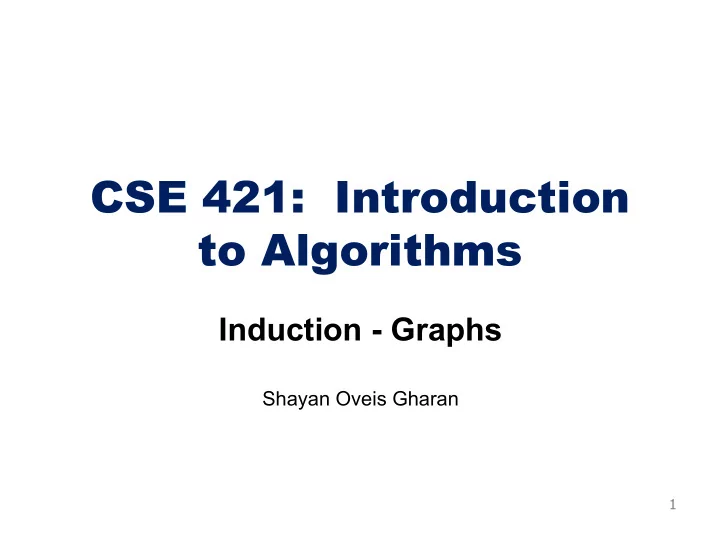

CSE 421: Introduction to Algorithms Induction)* Graphs Shayan&Oveis&Gharan 1
Graphs 2
Undirected)Graphs)G=(V,E) A 2 10 3 Disconnected)graph 11 12 4 8 Multi)edges 13 B 9 Isolated)vertices 6 Self)loop 7 3
Graphs'don’t'Live'in'Flat'Land Geometrical'drawing'is'mentally'convenient,'but' mathematically'irrelevant:' A 4'drawings'of'a'single'graph: 7 4 3 A A 4 7 7 4 7 4 3 A 3 3 4
Directed(Graphs 1 2 10 3 self(loop 11 12 4 8 13 5 Multi(edge 9 6 7 5
Terminology • Degree-of-a-vertex:-#-edges-that-touch-that-vertex 3 5 1 4 6 deg(6)=3 2 7 10 • Connected:-Graph-is-connected-if-there-is-a-path- between-every-two-vertices • Connected-component:-Maximal-set-of-connected- vertices 6
Terminology+(cont’d) 3 • Path:+A+sequence+of+distinct+vertices+ 5 s.t. each+vertex+is+connected+ 6 to+the+next+vertex+with+an+edge 4 1 • Cycle:+Path+of+length+>+2+that+has+ 2 the+same+start+and+end 10 1 • Tree:+A+connected+graph+with+no+cycles 2 5 3 4 6 7
Degree%Sum Claim:%In%any%undirected%graph,%the%number%of%edges%is% 1 2 ∑ %&'(&) * deg(/) ⁄ equal%to% Pf:% ∑ %&'(&) * deg(/) counts%every%edge%of%the%graph%exactly% twice@%once%from%each%end%of%the%edge. 3 5 1 4 6 2 |E|=8 7 10 1 deg / = 2 + 2 + 1 + 1 + 3 + 2 + 3 + 2 = 16 %&'(&) * 8
Odd#Degree#Vertices Claim:#In#any#undirected#graph,#the#number#of#odd#degree# vertices#is#even Pf:#In#previous#claim#we#showed#sum#of#all#vertex#degrees# is#even.#So#there#must#be#even#number#of#odd#degree# vertices,#because#sum#of#odd#number#of#odd#numbers#is# odd. 3 5 1 4 6 2 4#odd#degree#vertices 7 10 3,#4,#5,#6 9
Degree%1%vertices Claim:%If%G%has%no%cycle,%then%it%has%a%vertex%of%degree% ≤ 1 (So,%every%tree%has%a%leaf) Pf:%(By%contradiction) Suppose%every%vertex%has%degree% ≥ 2. Start%from%a%vertex% & ' and%follow%a%path,% & ' , … , & * when%we%are%at% & * we%choose%the%next%vertex%to%be%different%from% & *+' . We%can% do%so%because% deg & * ≥ 2. The%first%time%that%we%see%a%repeated%vertex%( & / = & * ) we%get%a% cycle.% We%always%get%a%repeated%vertex%because% 2 has%finitely%many% vertices & 4 & ' & 5 & 3 & 6 10
Trees%and%Induction Claim:%Show%that%every%tree%with%n%vertices%has%n81%edges. Pf:%By%induction. Base%Case: n=1,%the%tree%has%no%edge IH:%Suppose%every%tree%with%n81%vertices%has%n82%edges IS:%Let%T%be%a%tree%with%n%vertices. So,%T%has%a%vertex%v%of%degree%1. Remove%v%and%the%neighboring%edge,%and%let%T’%be%the%new% graph. We%claim%T’%is%a%tree:%It%has%no%cycle,%and%it%must%be%% connected. So,%T’%has%n82%edges%and%T%has%n81%edges. 11
#edges Let( ! = ($, &) be(a(graph(with( ( = |$| vertices(and( * = & edges. . = - -/0 - = 1(( . ) Claim:( 0 ≤ * ≤ . Pf:(Since(every(edge(connects(two(distinct(vertices((i.e.,(G( has(no(loops)( and(no(two(edges(connect(the(same(pair(of(vertices((i.e.,(G( has(no(multiBedges) It(has(at(most( - . edges. 12
Sparse'Graphs A'graph'is'called'sparse if' ! ≪ # $ and'it'is'called'dense' otherwise. Sparse'graphs'are'very'common'in'practice • Friendships'in'social'network • Planar'graphs • Web'braph Q:'Which'is'a'better'running'time' %(# + !) vs' %(# $ ) ? A:' %(# + !) = %(# $ ) ,'but' %(# + !) is'usually'much'better. 13
Storing(Graphs((Internally(in(ALG) 1 Vertex(set( ! = # $ , … , # ' . 2 Adjacency(Matrix:(A 4 • For(all,( ), *, + ), * = 1 iff( # - , # . ∈ 0 • Storage:( 1 2 bits 3 1 2 3 4 1 0 0 0 1 2 0 0 1 1 3 0 1 0 1 Advantage: 4 1 1 1 0 • 4(1) test(for(presence(or(absence(of(edges Disadvantage: • Inefficient(for(sparse(graphs(both(in(storage(and(edgeD access 14
Storing(Graphs((Internally(in(ALG) 1 Adjacency(List: 2 O(n+m)(words 4 3 Advantage • Compact(for(sparse • Easily(see(all(edges 4 1 3 4 2 Disadvantage 4 2 3 • No(O(1)(edge(test 1 2 3 4 • More(complex(data(structure 15
Storing(Graphs((Internally(in(ALG) 1 Adjacency(List: 2 O(n+m)(words 4 3 Advantage • Compact(for(sparse • Easily(see(all(edges 4 1 3 4 2 Disadvantage 4 2 3 • No(O(1)(edge(test 1 2 3 4 • More(complex(data(structure 16
Graph&Traversal Walk&(via&edges)&from&a&fixed&starting&vertex& ! to&all&vertices& reachable&from& ! . • Breadth&First&Search&(BFS):&Order&nodes&in&successive& layers&based&on&distance&from&s • Depth&First&Search&(DFS):&More&natural&approach&for& exploring&a&mazeG&many&efficient&algs build&on&it. Applications: • Finding&Connected&components&of&a&graph • Testing&Bipartiteness • Finding&Aritculation points 17
Breadth(First(Search((BFS) Completely explore(the(vertices(in(order(of(their(distance( from( ! . Three(states(of(vertices: • Undiscovered • Discovered • FullyAexplored Naturally(implemented(using(a(queue The(queue(will(always(have(the(list(of(Discovered(vertices 18
BFS$implementation Global$initialization:$mark$all$vertices$"undiscovered"$ BFS(s)$ mark$$s$"discovered" queue$=${$s$} while$queue$not$empty u$=$remove_first(queue) for$each$edge${u,x} if$(x$is$undiscovered)$ mark$x$discovered append$x$on$queue mark$u$fullyHexplored 19
Recommend
More recommend